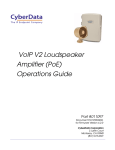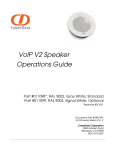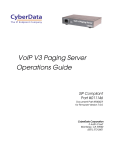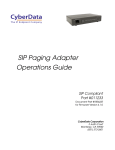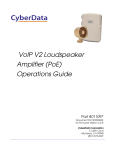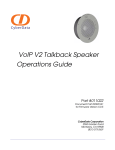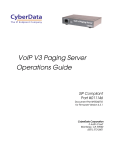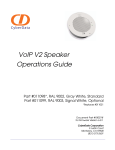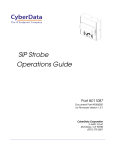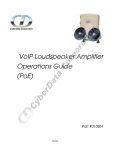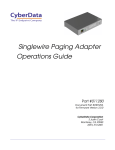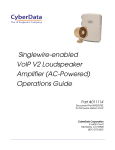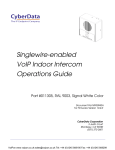Download VoIP V3 Paging Server Operations Guide
Transcript
The IP Endpoint Company VoIP V3 Paging Server Operations Guide SIP Compliant Part #011146 Document Part #930427D for Firmware Version 6.0.7 CyberData Corporation 3 Justin Court Monterey, CA 93940 (831) 373-2601 Operations Guide 930427D SIP Compliant 011146 COPYRIGHT NOTICE: © 2011, CyberData Corporation, ALL RIGHTS RESERVED. This manual and related materials are the copyrighted property of CyberData Corporation. No part of this manual or related materials may be reproduced or transmitted, in any form or by any means (except for internal use by licensed customers), without prior express written permission of CyberData Corporation. This manual, and the products, software, firmware, and/or hardware described in this manual are the property of CyberData Corporation, provided under the terms of an agreement between CyberData Corporation and recipient of this manual, and their use is subject to that agreement and its terms. DISCLAIMER: Except as expressly and specifically stated in a written agreement executed by CyberData Corporation, CyberData Corporation makes no representation or warranty, express or implied, including any warranty or merchantability or fitness for any purpose, with respect to this manual or the products, software, firmware, and/or hardware described herein, and CyberData Corporation assumes no liability for damages or claims resulting from any use of this manual or such products, software, firmware, and/or hardware. CyberData Corporation reserves the right to make changes, without notice, to this manual and to any such product, software, firmware, and/or hardware. OPEN SOURCE STATEMENT: Certain software components included in CyberData products are subject to the GNU General Public License (GPL) and Lesser GNU General Public License (LGPL) “open source” or “free software” licenses. Some of this Open Source Software may be owned by third parties. Open Source Software is not subject to the terms and conditions of the CyberData COPYRIGHT NOTICE or software licenses. Your right to copy, modify, and distribute any Open Source Software is determined by the terms of the GPL, LGPL, or third party, according to who licenses that software. Software or firmware developed by Cyberdata that is unrelated to Open Source Software is copyrighted by CyberData, subject to the terms of CyberData licenses, and may not be copied, modified, reverse-engineered, or otherwise altered without explicit written permission from CyberData Corporation. TRADEMARK NOTICE: CyberData Corporation and the CyberData Corporation logos are trademarks of CyberData Corporation. Other product names, trademarks, and service marks may be the trademarks or registered trademarks of their respective owners. Technical Support The IP Endpoint Company The fastest way to get technical support for your VoIP product is to submit a VoIP Technical Support form at the following website: http://www.cyberdata.net/support/contactsupportvoip.html We have several technical support staff monitoring this form and they will contact you within 12 hours after receiving a submission. Phone: (831) 373-2601, Ext. 333 Email: [email protected] Fax: (831) 373-4193 Company and product information is at www.cyberdata.net. CyberData Corporation 930427D Operations Guide Revision Information Revision 930427D, which corresponds to firmware version 6.0.7, was released on March 19, 2012, and has the following changes: • Updates Figure 2-11, "Device Configuration Page" to add the Beep on Page feature. • Updates Table 2-6, "Device Configuration Parameters" to add the Beep on Page feature. CyberData Corporation 930427D Operations Guide Important Safety Instructions 1. Read these instructions. 2. Keep these instructions. 3. Heed all warnings. 4. Follow all instructions. 5. Do not use this apparatus near water. 6. Clean only with dry cloth. 7. Do not block any ventilation openings. Install in accordance with the manufacturer’s instructions. 8. Do not install near any heat sources such as radiators, heat registers, stoves, or other apparatus (including amplifiers) that produce heat. 9. Do not defeat the safety purpose of the polarized or grounding-type plug. A polarized plug has two blades with one wider than the other. A grounding type plug has two blades and a third grounding prong. The wide blade or the third prong are provided for your safety. If the provided plug does not fit into your outlet, consult an electrician for replacement of the obsolete outlet. 10. Protect the power cord from being walked on or pinched particularly at plugs, convenience receptacles, and the point where they exit from the apparatus. 11. Only use attachments/accessories specified by the manufacturer. 12. Refer all servicing to qualified service personnel. Servicing is required when the apparatus has been damaged in any way, such as power-supply cord or plug is damaged, liquid has been spilled or objects have fallen into the apparatus, the apparatus has been exposed to rain or moisture, does not operate normally, or has been dropped. 13. Prior to installation, consult local building and electrical code requirements. Warning Electrical Hazard: This product should be installed by a licensed electrician according to all local electrical and building codes. GENERAL ALERT Warning Electrical Hazard: To prevent injury, this apparatus must be securely attached to the floor/wall in accordance with the installation instructions. GENERAL ALERT CyberData Corporation 930427D Operations Guide Pictorial Alert Icons GENERAL ALERT General Alert This pictoral alert indicates a potentially hazardous situation. This alert will be followed by a hazard level heading and more specific information about the hazard. Ground This pictoral alert indicates the Earth grounding connection point. Hazard Levels Danger: Indicates an imminently hazardous situation which, if not avoided, will result in death or serious injury. This is limited to the most extreme situations. Warning: Indicates a potentially hazardous situation which, if not avoided, could result in death or serious injury. Caution: Indicates a potentially hazardous situation which, if not avoided, could result in minor or moderate injury. It may also alert users against unsafe practices. Notice: Indicates a statement of company policy (that is, a safety policy or protection of property). The safety guidelines for the equipment in this manual do not purport to address all the safety issues of the equipment. It is the responsibility of the user to establish appropriate safety, ergonomic, and health practices and determine the applicability of regulatory limitations prior to use. Potential safety hazards are identified in this manual through the use of words Danger, Warning, and Caution, the specific hazard type, and pictorial alert icons. CyberData Corporation 930427D Operations Guide Abbreviations and Terms Abbreviation or Term Definition A-law A standard companding algorithm, used in European digital communications systems to optimize, i.e., modify, the dynamic range of an analog signal for digitizing. AVP Audio Video Profile Cat 5 TIA/EIA-568-B Category 5 DHCP Dynamic Host Configuration Protocol LAN Local Area Network LED Light Emitting Diode Mbps Megabits per second. NTP Network Time Protocol PBX Private Branch Exchange PoE Power over Ethernet (as per IEEE 802.3af standard) RTFM Reset Test Function Management SIP Session Initiated Protocol u-law A companding algorithm, primarily used in the digital telecommunication UC Unified Communications VoIP Voice over Internet Protocol CyberData Corporation 930427D Operations Guide i Contents Chapter 1 Product Overview 1 1.1 How to Identify This Product ..............................................................................................................2 1.2 Product features .....................................................................................................................................3 1.3 Supported ................................................................................................................................................3 1.4 Product Specifications ...........................................................................................................................4 Chapter 2 Setting Up the V3 Paging Server 5 2.1 Parts List ..................................................................................................................................................5 2.2 Typical Installation .................................................................................................................................6 2.3 Connecting the V3 Paging Server ........................................................................................................7 2.3.1 Connection Options ....................................................................................................................7 Pin 1 and 2—Fault Sense Input (Common/Sense) ..................................................................8 Pin 3, 4, and 5—Positive/Negative 600-Ohm Audio Output/Audio Ground Reference .8 Pin 6 and 7—Relay Contact (Common/Normally Open) ......................................................8 2.3.2 Removable Connector ................................................................................................................8 2.3.3 Connect to the Power Source ...................................................................................................9 Poe ..................................................................................................................................................9 Non-Poe .........................................................................................................................................9 Chassis Ground .............................................................................................................................9 2.3.4 Connect to the Network .......................................................................................................... 10 2.3.5 Confirm that the V3 Paging Server is Up and Running ..................................................... 11 Confirm Power on, Network Connectivity, and Connection Speed .................................. 11 Verify Network Activity ........................................................................................................... 11 2.3.6 Announcing the IP Address .................................................................................................... 11 2.3.7 Restore the Factory Default Settings ...................................................................................... 12 2.4 Configuring the V3 Paging Server ....................................................................................................13 2.4.1 Gather the Required Configuration Information ................................................................ 13 Static or DHCP Addressing? ....................................................................................................13 Username and Password for Configuration GUI .................................................................13 SIP Settings ................................................................................................................................. 13 2.4.2 V3 Paging Server Web Page Navigation ................................................................................ 14 2.4.3 Log in to the Configuration GUI ............................................................................................15 2.4.4 Configure the Device Parameters ...........................................................................................18 2.4.5 Configure the Network Parameters ...................................................................................... 20 2.4.6 Configure the SiP Parameters ................................................................................................. 22 Point-to-Point Configuration ....................................................................................................25 2.4.7 Configure the Night Ringer Parameters ................................................................................ 26 2.4.8 Configure the Sensor Parameters ...........................................................................................28 2.4.9 Configure the Paging Groups (PGROUPS) Parameters ...................................................... 30 2.4.10 Operating the Paging Server ................................................................................................. 33 2.4.11 Configure the Audio Parameters .......................................................................................... 34 User-created Audio Files ........................................................................................................... 37 2.4.12 Configure the Event Parameters ...........................................................................................39 Example Packets for Events ...................................................................................................... 41 2.4.13 Configure the Autoprovisioning Parameters ...................................................................... 44 Autoprovisioning ....................................................................................................................... 46 2.5 Upgrading the Firmware ................................................................................................................... 49 Upgrade the Firmware .............................................................................................................. 50 Appendix A Setting Up a TFTP Server CyberData Corporation 930427D 51 Operations Guide ii A.1 Set up a TFTP Server .......................................................................................................................... 51 A.1.1 In a LINUX Environment ........................................................................................................ 51 A.1.2 In a Windows Environment ................................................................................................... 51 Appendix B Troubleshooting/Technical Support 52 B.1 Frequently Asked Questions (FAQ) .................................................................................................. 52 B.1.1 Documentation .......................................................................................................................... 52 B.2 Contact Information ............................................................................................................................ 53 B.3 Warranty ............................................................................................................................................... 54 B.3.1 Warranty & RMA Returns within the United States ........................................................... 54 B.3.2 Warranty & RMA Returns Outside of the United States .................................................... 54 B.3.3 Spare in the Air Policy .............................................................................................................54 B.3.4 Return and Restocking Policy ................................................................................................. 55 B.3.5 Warranty and RMA Returns Page .......................................................................................... 55 CyberData Corporation 930427D Operations Guide 1 1 Product Overview The CyberData V3 VoIP Paging Server enables users through a single SIP phone extension, to access multiple zones for paging in a VoIP network and to connect to legacy analog overhead paging systems. A second SIP extension can be configured as a night ringer playing a user-uploadable audio file. The V3 Paging Server allows direct connection to legacy analog paging amplifiers that require a "Page Port" type of input that meets a balanced 600 Ohm 10Vpp signal or a 10k Ohm Hi-Z 2vpp signal. You can also take advantage of connections for a dry contact relay (page start output) and sense input (Fault Sense Input) for additional functionality. The easy-to-use, web-based configuration provides a graphical user interface to set up to 100 paging zones for IP paging with unique multicast address and port number combinations. The V3 Paging Server connects via a single CAT 5 or 6 network cable to a standard PoE 802.3af compliant switch. CyberData Corporation 930427D Operations Guide Product Overview 2 How to Identify This Product 1.1 How to Identify This Product To identify the VoIP V3 Paging Server, look for a model number label similar to the one shown in Figure 1-1. The model number on the label should be 011146. Figure 1-1. Model Number Label WWW.CYBERDATA.NET V3 VoIP PAGING SERVER RoHS COMPLIANT 011146B / 021059C 146000001 Model number CyberData Corporation 930427D Operations Guide Product Overview 3 Product features 1.2 Product features ● SIP RFC 3261 compatible ● Multicast output ● Two SIP endpoints (one for Night Ringer) ● DTMF control of zone selection ● Page Start Relay contacts ● Remote amp fault sensor ● Delayed page support ● Line-In connection for music-on-hold multicasting ● Line-out connection to support analog Amps ● User uploadable audio files ● Web-based configuration and firmware upload ● PoE 802.3af enabled (Power-over-Ethernet) ● 19-inch Rack mount option 1.3 Supported ● HTTP Web-based configuration Provides an intuitive GUI for easy system configuration and verification of speaker operations. ● DHCP Client ● TFTP Client ● RTP Version 2 Multicast and Unicast ● Audio Codec CyberData Corporation • G.711 U-law • DTMF detection 930427D Operations Guide Product Overview 4 Product Specifications 1.4 Product Specifications Table 1-1. Product Specifications Specifications Regulatory Compliance FCC Class A, UL 60950, CE Power Requirement PoE or 48V DC Connection Speed 10/100 Mbps Protocol SIP compliant Page Port Output Balanced 600 Ohm 10VPP Line In: Input Signal Amplitudes 2.0 VPP maximum Input Impedance 10k Ohm Line Out: Output Signal Amplitudes 2.0 VPP maximum Output Level +2dBm nominal Total Harmonic Distortion 0.5% maximum Output Impedance 10k Ohm Part Number 011146 Dimensions 6.11” L x 4.05” W x 1.15” H Weight 1.2 pounds CyberData Corporation 930427D Operations Guide 5 2 Setting Up the V3 Paging Server The topics in this chapter provide information on setting up, configuring, and using the VoIP V3 Paging Server. 2.1 Parts List The packaging for the V3 Paging Server includes the parts in Table 2-2. Table 2-2. Parts List Quantity CyberData Corporation Part Name Illustration 1 V3 Paging Server 1 Installation Quick Reference Guide 1 Mounting Template (located on the last page of the Installation Quick Reference) 1 Mounting Kit (part #070057A) which includes: (2) #4-6 x 7/8" Mounting Anchors (2) #4 x 1-1/4" Round Phillips Wood Screws 930427D Operations Guide Setting Up the V3 Paging Server 6 Typical Installation 2.2 Typical Installation Figure 2-2 illustrates how the V3 Paging Server is normally installed as part of a paging system. Figure 2-2. Typical Installation CyberData Corporation 930427D Operations Guide Setting Up the V3 Paging Server 7 Connecting the V3 Paging Server 2.3 Connecting the V3 Paging Server Before you connect the V3 Paging Server, be sure that you have received all of the parts described in Section 2.1, "Parts List". 2.3.1 Connection Options See Figure 2-3 and Table 2-1 for the connection options that are available for the V3 Paging Server. Figure 2-3. Connection Options Line In Line Out Page Port Output Power Pin 1 Pin2 Pin 3 Pin 4 Pin 5 48VDC Pin 6 Pin 7 Table 2-1. Page Port Output Connections Pin Description 1 Fault Sense Input (Common). See Section 2.3.1.1, "Pin 1 and 2—Fault Sense Input (Common/Sense)". 2 Fault Sense Input (Sense). See Section 2.3.1.1, "Pin 1 and 2—Fault Sense Input (Common/Sense)". 3 Positive 600-Ohm Audio Outputa. See Section 2.3.1.2, "Pin 3, 4, and 5—Positive/Negative 600Ohm Audio Output/Audio Ground Reference". 4 Negative 600-Ohm Audio Output.a. See Section 2.3.1.2, "Pin 3, 4, and 5—Positive/Negative 600Ohm Audio Output/Audio Ground Reference". 5 Audio Ground Reference. See Section 2.3.1.2, "Pin 3, 4, and 5—Positive/Negative 600-Ohm Audio Output/Audio Ground Reference". 6 Relay Contact - Commonb. See Section 2.3.1.3, "Pin 6 and 7—Relay Contact (Common/Normally Open)". 7 Relay Contact - Normally Openb. See Section 2.3.1.3, "Pin 6 and 7—Relay Contact (Common/Normally Open)". a. The 600-Ohm audio output of the page port is also suited for interfaces with lower input impedances. b. 1 Amp at 30 VDC for continuous loads CyberData Corporation 930427D Operations Guide Setting Up the V3 Paging Server 8 Connecting the V3 Paging Server 2.3.1.1 Pin 1 and 2—Fault Sense Input (Common/Sense) This input was designed as a method of monitoring an external amplifier that is equipped with a fault sense relay. When enabled via the web interface (Section 2.4.8, "Configure the Sensor Parameters"), this input (when closed) will play a user uploadable audio file out of the line-out connection and/or place a SIP call to a pre-determined extension and play that file. 2.3.1.2 Pin 3, 4, and 5—Positive/Negative 600-Ohm Audio Output/Audio Ground Reference This output allows direct connection to paging amplifiers requiring a "Page Port" type input that meets a balanced 600 Ohm 10Vpp signal. 2.3.1.3 Pin 6 and 7—Relay Contact (Common/Normally Open) When enabled on the web interface (Section 2.4.4, "Configure the Device Parameters"), every time an audio file is played out of the local line-out or 600 Ohm output, the relay will close, thereby enabling amplifiers with a remote turn-on capability to become active. 2.3.2 Removable Connector Figure 2-4 shows the connector that is removable on the V3 Paging Server. Figure 2-4. Removable Connector CyberData Corporation 930427D Operations Guide Setting Up the V3 Paging Server 9 Connecting the V3 Paging Server 2.3.3 Connect to the Power Source To use PoE, plug a Cat 5 Ethernet cable from the V3 Paging Server Ethernet port to your network. As an alternative to PoE, you can plug one end of a +48V DC power supply into the Paging Server, and plug the other end into a receptacle. If required, connect the earth grounding wire to the chassis ground on the back of the unit. See Figure 2-5. Figure 2-5. Connecting to the Power Source PoE To set up the V3 Paging Server, connect the device to your network: Poe ● Non PoE (with 48 VDC power supply) For PoE, plug one end of an 802.3af Ethernet cable into the V3 Paging Server Ethernet port. Plug the other end of the Ethernet cable into your network. See the figure on the left. 48VDC Non-Poe ● For Non-PoE, connect the V3 Paging Server to a 48VDC power supply. See the figure on the left. Chassis Ground Chassis Ground ● If required, connect the earth grounding wire to the Chassis Ground. See the figure on the left. Chassis Ground CyberData Corporation 930427D Operations Guide Setting Up the V3 Paging Server 10 Connecting the V3 Paging Server 2.3.4 Connect to the Network Plug one end of a standard Ethernet cable into the Paging Server Ethernet port. Plug the other end into your network. Figure 2-6. Connecting to the Network CyberData Corporation 930427D Operations Guide Setting Up the V3 Paging Server 11 Connecting the V3 Paging Server 2.3.5 Confirm that the V3 Paging Server is Up and Running The LEDs on the front of the V3 Paging Server verify the unit’s operations. Figure 2-7. Paging Server LEDs Link (GREEN/AMBER LED) Activity (GREEN LED) Status (GREEN/BLUE LED) Paging (GREEN LED) 2.3.5.1 Confirm Power on, Network Connectivity, and Connection Speed When you plug in the Ethernet cable or power supply: • The round, GREEN/BLUE Status LED on the front of the V3 Paging Server comes on indicating that the power is on. Once the device has been initialized, this LED blinks at one second intervals. • The square, GREEN/AMBER Link LED above the Ethernet port indicates that the network connection has been established. The Link LED changes color to confirm the auto-negotiated connection speed: • The Link LED is GREEN at 10 Mbps. • The Link LED is AMBER at 100 Mbps. • The GREEN Paging LED comes on after the device is booted and initialized. This LED blinks when a page is in progress. You can disable Beep on Initialization on the Device Configuration page. 2.3.5.2 Verify Network Activity The square, GREEN Activity LED blinks when there is network traffic. 2.3.6 Announcing the IP Address To announce the IP address for the V3 Paging Server, briefly press and then quickly release the RTFM switch. See Figure 2-8. Figure 2-8. RTFM Switch RTFM Switch CyberData Corporation 930427D Operations Guide Setting Up the V3 Paging Server 12 Connecting the V3 Paging Server 2.3.7 Restore the Factory Default Settings The V3 Paging Server is delivered with factory set default values for the parameters in Table 2-3. Use the RTFM switch (see Figure 2-9) on the back of the unit to restore these parameters to the factory default settings. Figure 2-9. RTFM Switch RTFM Switch Note When you perform this procedure, the factory default settings are restored. The default parameters for access are shown in Table 2-3. Table 2-3. Factory Default Settings Parameter Factory Default Setting IP Addressing DHCP IP Addressa 10.10.10.10 Web Access Username admin Web Access Password admin Subnet Maska 255.0.0.0 Default Gatewaya 10.0.0.1 a. Default if there is not a DHCP server present. To restore these parameters to the factory default settings: 1. Press and hold the RTFM switch until the status and paging lights come on. 2. Continue to press the switch until after the indicator lights go off, and then release it. 3. The V3 Paging Server settings are restored to the factory defaults. CyberData Corporation 930427D Operations Guide Setting Up the V3 Paging Server 13 Configuring the V3 Paging Server 2.4 Configuring the V3 Paging Server Use this section to configure the VoIP paging server. 2.4.1 Gather the Required Configuration Information Have the following information available before you configure the V3 Paging Server. 2.4.1.1 Static or DHCP Addressing? Know whether your system uses static or dynamic (DHCP) IP addressing. If it uses static addressing, you also need to know the values to assign to the following V3 Paging Server parameters: • IP Address • Subnet Mask • Default Gateway 2.4.1.2 Username and Password for Configuration GUI Determine the Username and Password that will replace the defaults after you initially log in to the configuration GUI. • The Username is case-sensitive, and must be from four to 25 alphanumeric characters long. • The Password is case-sensitive, and must be from four to 20 alphanumeric characters long. 2.4.1.3 SIP Settings To configure the SIP parameters, determine whether you want to register with the server. If you do, determine the number of minutes the registration lease remains valid, and whether you want to automatically unregister when you reboot. To configure the SIP parameters, you also need to determine the values for these parameters: • SIP Server IP Address • Remote and Local SIP Port Numbers • SIP User ID, and Authenticate ID and Password for this User ID CyberData Corporation 930427D Operations Guide Setting Up the V3 Paging Server 14 Configuring the V3 Paging Server 2.4.2 V3 Paging Server Web Page Navigation Table 2-4 shows the navigation buttons that you will see on every V3 Paging Server web page. Table 2-4. V3 Paging Amplifier Web Page Navigation Web Page Item Description Link to the Home page. Link to the Device Configuration page. Link to the Networking page. Link to go to the SIP Configuration page. Link to go to the Nightringer page. Link to go to the Sensor Configuration page. Link to go to the Paging Groups Configuration page. Link to the Audio Configuration page. Link to the Event Configuration page. Link to the Autoprovisioning Configuration page. Link to the Update Firmware page. CyberData Corporation 930427D Operations Guide Setting Up the V3 Paging Server 15 Configuring the V3 Paging Server 2.4.3 Log in to the Configuration GUI 1. Open your browser to the V3 Paging Server IP address. Note If the network does not have access to a DHCP server, the device will default to an IP address of 10.10.10.10. Note Make sure that the PC is on the same IP network as the V3 Paging Server. Note You may also download CyberData’s VoIP Discovery Utility program which allows you to easily find and configure the default web address of the CyberData VoIP products. CyberData’s VoIP Discovery Utility program is available at the following website address: http://www.cyberdata.net/support/voip/discovery_utility.html The unit ships in DHCP mode. To get to the Home page, use the discovery utility to scan for the device on the network and open your browser from there. Note To work with the V3 Paging Server configuration after the initial configuration, log in using the IP address you assign to the device. Section 2.4.5, "Configure the Network Parameters" provides instructions for entering the IP address. 2. When prompted, use the following default Username and Password to open the configuration Home page: Username: admin Password: admin Change the To change the default Web access Username and Password: Default Username 1. Enter the new Username from four to 25 alphanumeric characters in the Change Username and Password field. The Username is case-sensitive. 2. Enter the new Password from four to 20 alphanumeric characters in the Change Password field. The Password is case-sensitive. 3. Enter the new password again in the Re-enter New Password field. Click Save Settings. CyberData Corporation 930427D Operations Guide Setting Up the V3 Paging Server 16 Configuring the V3 Paging Server Figure 2-10. Home Page CyberData Corporation 930427D Operations Guide Setting Up the V3 Paging Server 17 Configuring the V3 Paging Server 4. On the Home Page, review the setup details and navigation buttons described in Table 2-5. Table 2-5. Home Page Overview Web Page Item Description Device Settings Device Name Shows the device name (25 character limit). Change Username Type in this field to change the username (25 character limit). Change Password Type in this field to change the password (19 character limit). Re-enter Password Type the password again in this field to confirm the new password (19 character limit). Current Settings Serial Number Shows the device serial number. Mac Address Shows the device Mac address. Firmware Version Shows the current firmware version. IP Addressing Shows the current IP addressing setting (DHCP or Static). IP Address Shows the current IP address. Subnet Mask Shows the current subnet mask address. Default Gateway Shows the current default gateway address. DNS Server 1 Shows the current DNS Server 1 address. DNS Server 2 Shows the current DNS Server 2 address. SIP Mode is Shows the current status of the SIP Mode. Event Reporting is Shows the current status of the Event Reporting. Nightring is Shows the current status of the Nightringer. Click the Save button to save your configuration settings. Note: You need to reboot for changes to take effect. Click on the Reboot button to reboot the system. At this point you can: • Review the V3 Paging Server’s Current Settings. Use the RTFM switch to restore the factory default settings. See 2.3.7 "Restore the Factory Default Settings". • Configure the network parameters. Click Network Setup and refer to Section 2.4.5, "Configure the Network Parameters" for instructions. • Configure the SIP parameters. Click SIP Setup and see Section 2.4.6, "Configure the SiP Parameters". • Configure the PGROUPS parameters. Click PGROUPS Setup and see Section 2.4.9, "Configure the Paging Groups (PGROUPS) Parameters" for instructions. Note CyberData Corporation Click the Upgrade Firmware button any time you need to upload new versions of the firmware. Refer to Section 2.5, "Upgrading the Firmware" for instructions. 930427D Operations Guide Setting Up the V3 Paging Server 18 Configuring the V3 Paging Server 2.4.4 Configure the Device Parameters 1. Click the Device Configuration button to open the Device Configuration page. See Figure 2-11. Figure 2-11. Device Configuration Page CyberData Corporation 930427D Operations Guide Setting Up the V3 Paging Server 19 Configuring the V3 Paging Server 2. On the Device Configuration page, you may enter values for the parameters indicated in Table 2-6. Table 2-6. Device Configuration Parameters Web Page Item Description Miscellaneous Settings Beep on Initialization When selected, you will hear a beep when the speaker initializes. Beep on Page When selected, the device will play a beep before a page is sent on SIP calls (works for both buffered and live pages). Enable Line In to Line Out Loopback When selected, audio is sent from the line -in to the line-out output. Enable Line-In to Multicast When selected, the line-in audio will be multicast to the address and port specified on the web page. Note: Ideally, the specified address and port will match that of a low priority MGROUP (such as background music) on the speakers or paging amplifiers. Note: When line-in to multicast is selected, do not set that multicast address and port to the same multicast address and port that is used by one of your PGROUPS. Otherwise, when you call the PGROUP, the Paging Server will be unable to send the new audio stream because the port will already be in use by the line-in to multicast stream. Multicast Address Type the Multicast address. Multicast Port Type the Multicast port number. Enable Relay on Local Audio When selected, the relay will be closed any time that audio is played out of the line-out/page port. This setting is for legacy analog amplifiers that are often connected to the page port. Analog amplifiers will often have a noticeable hum if they are turned on while there is no audio being played. The relay closure causes these amplifiers to turn on only when audio is sent to them. Click the Save button to save your configuration settings. Note: You need to reboot for changes to take effect. Click on the Test Audio button to do an audio test. When the Test Audio button is pressed, you will hear a voice message for testing the device audio quality and volume. Click on the Reboot button to reboot the system. 3. After changing the parameters, click the Save button. CyberData Corporation 930427D Operations Guide Setting Up the V3 Paging Server 20 Configuring the V3 Paging Server 2.4.5 Configure the Network Parameters Configuring the network parameters enables your network to recognize the V3 Paging Server and communicate with it. Click Network Setup on the Home page to open the Network Configuration page. Figure 2-12. Network Setup Page CyberData Corporation 930427D Operations Guide Setting Up the V3 Paging Server 21 Configuring the V3 Paging Server On the Network Setup page, enter values for the parameters indicated in Table 2-7. Table 2-7. Network Configuration Parameters Web Page Item Description Stored Network Settings Shows the settings stored in non-volatile memory. IP Addressing Select either DHCP IP Addressing or Static IP Addressing by marking the appropriate radio button. If you select Static, configure the remaining parameters indicated in Table 2-7. If you select DHCP, go to Step 3. IP Address Enter the Static IP address. Subnet Mask Enter the Subnet Mask address. Default Gateway Enter the Default Gateway address. DNS Server 1 Enter the DNS Server 1 address. DNS Server 2 Enter the DNS Server 2 address. Current Network Settings Shows the current network settings. IP Address Shows the current Static IP address. Subnet Mask Shows the current Subnet Mask address. Default Gateway Shows the current Default Gateway address. DNS Server 1 Shows the current DNS Server 1 address. DNS Server 2 Shows the current DNS Server 2 address. Click the Save button to save your configuration settings. Note: You need to reboot for changes to take effect. Click on the Reboot button to reboot the system. On this page: 1. Specify whether you use Static or DHCP IP Addressing by marking the appropriate radio button. Then, if you select Static, go to Step 2. 2. For Static IP Addressing, also enter values for the following parameters: • The V3 Paging Server’s IP Address: The V3 Paging Server is delivered with a factory default IP address. Change the default address to the correct IP address for your system. • The Subnet Mask. • The Default Gateway. 3. Click Save when you are finished. 4. Click Reboot for the new settings to take effect. CyberData Corporation 930427D Operations Guide Setting Up the V3 Paging Server 22 Configuring the V3 Paging Server 2.4.6 Configure the SiP Parameters The SIP parameters enable the V3 Paging Server to contact and register with the SIP server. On the Home page, click SIP Config to open the SIP Configuration page. Figure 2-13. SIP Configuration Page CyberData Corporation 930427D Operations Guide Setting Up the V3 Paging Server 23 Configuring the V3 Paging Server 5. On the SIP Setup page, enter values for the parameters indicated in Table 2-8. Table 2-8. SIP Configuration Parameters Web Page Item Description SIP Settings SIP Server Type the SIP server represented as either a numeric IP address in dotted decimal notation or the fully qualified host name (255 character limit [FQDN]). Remote SIP Port Type the Remote SIP Port number (default 5060) (8 character limit). Local SIP Port Type the Local SIP Port number (default 5060) (8 character limit). Outbound Proxy Type the Outbound Proxy as either a numeric IP address in dotted decimal notation or the fully qualified host name (255 character limit [FQDN]). Outbound Proxy Port Type the Outbound Proxy Port number (8 character limit). SIP User ID Type the SIP User ID (up to 64 alphanumeric characters). Authenticate ID Type the Authenticate ID (up to 64 alphanumeric characters). Authenticate Password Type the Authenticate Password (up to 64 alphanumeric characters). Register with a SIP Server Enable or disable SIP Registration. For information about Point-to-Point Configuration, see Section 2.4.6.1, "Point-to-Point Configuration". Re-registration Interval (in seconds) Type the SIP Registration lease time in seconds (default is 60 minutes) (8 character limit). Re-registration Interval (in seconds) Unregister on Reboot When selected, on boot, the device will first register with a SIP server with a expiration delay of 0 seconds. This has the effect of unregistering any current devices on this extension. Buffer SIP Calls When this is enabled, SIP calls to the device will be stored in memory and will play when either the call is terminated or the buffer is full. The receive buffer is 2MB in size and this is equal to about four minutes of ulaw encoded audio. Click the Save button to save your configuration settings. Note: You need to reboot for changes to take effect. Click on the Reboot button to reboot the system. 1. Enter the IP address of the SIP Server. 2. Enter the port numbers used for SIP signaling: a. Remote SIP Port b. Local SIP Port 3. Enter the SIP registration parameters: a. SIP User ID CyberData Corporation 930427D Operations Guide Setting Up the V3 Paging Server 24 Configuring the V3 Paging Server b. Authenticate ID c. Authenticate Password 4. For SIP Registration, designate whether you want the VoIP Paging Server to register with your SIP server. 5. At Unregister on Reboot: a. Select Yes to automatically unregister the V3 Paging Server when you reboot it. b. Select No to keep the V3 Paging Server registered when you reboot it. 6. In the Register Expiration field, enter the number of seconds the V3 Paging Server registration lease remains valid with the SIP Server. The V3 Paging Server automatically re-registers with the SIP server before the lease expiration timeout. 7. Click Save. 8. Click Reboot for the new settings to take effect. CyberData Corporation 930427D Operations Guide Setting Up the V3 Paging Server 25 Configuring the V3 Paging Server 2.4.6.1 Point-to-Point Configuration When the board is set to not register with a SIP server, it's possible to set the device to dial out to a single endpoint. To do this, do the following: 1. On the SIP Configuration page (Figure 2-14), make sure that the Register with a SIP Server parameter is not selected. 2. Type the IP address of the remote device that you want to contact into the Dial out Extension field Note The delayed DTMF functionality is available in the Point-to-Point Mode. Note Establishing point-to-point SiP calls may not work with all phones. Figure 2-14. SIP Configuration Page Set to Point-to-Point Mode Device is set to NOT register with a SIP server CyberData Corporation 930427D Operations Guide Setting Up the V3 Paging Server 26 Configuring the V3 Paging Server 2.4.7 Configure the Night Ringer Parameters 1. Click on the Nightringer button to open the Nightringer Configuration page. See Figure 2-15. Figure 2-15. Nightringer Configuration Setup CyberData Corporation 930427D Operations Guide Setting Up the V3 Paging Server 27 Configuring the V3 Paging Server 2. On the Nightringer Configuration page, enter values for the parameters indicated in Table 2-9. Table 2-9. Nightringer Configuration Parameters Web Page Item Description Enable Nightringer When the nightringer is enabled, the unit will attempt to register a second extension with the SIP server. Any calls made to this extension will play a ringtone. Nightringer Settings SIP Server Type the SIP server represented as either a numeric IP address in dotted decimal notation. Remote SIP Port Type the Remote SIP Port number (default 5060) (8 character limit). Local SIP Port Type the Local SIP Port number (default 5061) (8 character limit). Note: This value cannot be the same as the Local SIP Port found on the SIP Configuration Page. User ID Type the User ID (up to 64 alphanumeric characters). Authenticate ID Type the Authenticate ID (up to 64 alphanumeric characters). Authenticate Password Type the Authenticate Password (up to 64 alphanumeric characters). Re-registration Interval (in seconds) Type the SIP Registration lease time in seconds (default is 60 minutes) (8 character limit). Re-registration Interval (in seconds) Relay Rings to Multicast When selected, a user-defined audio file is sent to the specified multicast address and port when the night ringer is activated. Multicast Address Type the Multicast address. Multicast Port Type the Multicast port number. Click the Save button to save your configuration settings. Note: You need to reboot for changes to take effect. Click on the Reboot button to reboot the system. 3. After changing the parameters, click on the Save button. 4. Click Reboot for the new settings to take effect. CyberData Corporation 930427D Operations Guide Setting Up the V3 Paging Server 28 Configuring the V3 Paging Server 2.4.8 Configure the Sensor Parameters 1. Click on the Sensor Config button to open the Sensor Configuration page. See Figure 2-16. Figure 2-16. Sensor Configuration Setup CyberData Corporation 930427D Operations Guide Setting Up the V3 Paging Server 29 Configuring the V3 Paging Server 2. On the Sensor Configuration page, enter values for the parameters indicated in Table 2-10. Table 2-10. Nightringer Configuration Parameters Web Page Item Description Sensor Settings Play Audio Locally When selected, when the sensor is triggered, the audio file for "Sensor Triggered" will play out of the line-out and 600Ohm connectors. Make Call to Extension When selected, when the sensor is triggered, the Paging Server will call the Dial Out Extension and play the "Sensor Triggered" audio file when someone answers. Dial Out Extension Enter the Dial Out Extension that you want the Paging Server to call when the sensor is triggered. Dial Out ID Enter the caller ID for Dial Out Extension. Click the Save button to save your configuration settings. Note: You need to reboot for changes to take effect. Click on the Reboot button to reboot the system. 3. After changing the parameters, click on the Save button. 4. Click Reboot for the new settings to take effect. CyberData Corporation 930427D Operations Guide Setting Up the V3 Paging Server 30 Configuring the V3 Paging Server 2.4.9 Configure the Paging Groups (PGROUPS) Parameters Note A PGROUP is a way of assigning multicast addresses and port numbers when configuring multicast paging speakers. To assign a multicast address, you must first configure the CyberData VoIP speakers that you want to put into a paging zone by entering a particular multicast address and port number combination in the web configuration for these speakers. 1. Click on the PGROUPS Setup button to open the PGROUPS Setup page. See Figure 2-17. Figure 2-17. PGROUPS Setup CyberData Corporation 930427D Operations Guide Setting Up the V3 Paging Server 31 Configuring the V3 Paging Server Figure 2-18. PGROUPS Setup (continued) CyberData Corporation 930427D Operations Guide Setting Up the V3 Paging Server 32 Configuring the V3 Paging Server Figure 2-19. PGROUPS Setup (continued) CyberData Corporation 930427D Operations Guide Setting Up the V3 Paging Server 33 Configuring the V3 Paging Server 2. On the PGROUPS Setup page, enter values for the parameters indicated in Table 2-11. Table 2-11. PGROUPS Setup Parameters Web Page Item Description Bypass DTMF When selected, bypassing the DTMF will result in all calls being relayed to PGROUP 0. # Shows the paging group number. Address Enter the IP address of the PGROUP. Port Enter the port number of the PGROUP. Name Enter a name for the PGROUP. TTL The TTL field allows you to adjust the TTL. TTL is "time to live" and it describes how many networks (routers) a packet will go through before it is discarded. For more information, see Appendix C, ”How to Use the Multicast Extensions. Lineout The Lineout field determines whether or not the V3 Paging Server will play audio out of the line-out port in addition to forwarding it to the Pgroup. 3. After changing the parameters, click Save Settings. 2.4.10 Operating the Paging Server • When you call to make a page, the V3 Paging Server generates a tone over the phone. • When you hear this tone, enter the two-digit code for the zone that you want to page. • The V3 Paging Server establishes a connection to a zone. • The V3 Paging Server generates another tone to the phone. • When you hear this tone, you can begin speaking. Note CyberData Corporation For page-all, you simply configure all speakers with a particular multicast address and port number combination, which represents one of the 100 zones that the paging server will support initially. Each speaker can still be part of 100 other paging zones in addition to the one page-all zone. 930427D Operations Guide Setting Up the V3 Paging Server 34 Configuring the V3 Paging Server 2.4.11 Configure the Audio Parameters Click the Audio Config button to open the Audio Configuration page. See Figure 2-20. The Audio Configuration page is used to add custom audio to the board. User uploaded audio will take precedence over the audio files shipped with the Intercom. Figure 2-20. Audio Configuration Page CyberData Corporation 930427D Operations Guide Setting Up the V3 Paging Server 35 Configuring the V3 Paging Server Figure 2-21. Audio Configuration Page CyberData Corporation 930427D Operations Guide Setting Up the V3 Paging Server 36 Configuring the V3 Paging Server On the Audio Configuration page, enter values for the parameters indicated in Table 2-12. Note Each entry on the Audio Configuration page replaces one of the stock audio files on the board. When the input box displays the word default, the V3 Paging Server is using the stock audio file. If that file is replaced with a user file, it will display the uploaded filename. Table 2-12. Audio Configuration Parameters Web Page Item Description Audio Files 0-9 The name of the audio configuration option is the same as the spoken audio that plays on the board (24 character limit). '0' corresponds to the spoken word “zero.” '1' corresponds to the spoken word “one.” '2' corresponds to the spoken word “two.” '3' corresponds to the spoken word “three.” '4' corresponds to the spoken word “four.” '5' corresponds to the spoken word “five.” '6' corresponds to the spoken word “six.” '7' corresponds to the spoken word “seven.” '8' corresponds to the spoken word “eight.” '9' corresponds to the spoken word “nine.” Dot Corresponds to the spoken word “dot.” (24 character limit). Audiotest Corresponds to the message “This is the CyberData IP speaker test message...” (24 character limit). Pagetone Corresponds to a simple tone that is unused by default (24 character limit). Invalid PGROUP Corresponds to the message “Invalid PGROUP” (24 character limit). Your IP Address is Corresponds to the message “Your IP address is...” (24 character limit). Rebooting Corresponds to the spoken word “Rebooting” (24 character limit). Restoring default Corresponds to the message “Restoring default” (24 character limit). Sensor Triggered Corresponds to the message “Sensor Triggered” (24 character limit). Night Ring Specifies the ringtone for nightring. By default this parameter uses the same audio file that is selected for the Ring Tone parameter. The Browse button will allow you to navigate to and select an audio file. The Play button will play that audio file. The Delete button will delete any user uploaded audio and restore the stock audio file. The Save button will download a new user audio file to the board once you've selected the file by using the Browse button. The Save button will delete any pre-existing user-uploaded audio files. CyberData Corporation 930427D Operations Guide Setting Up the V3 Paging Server 37 Configuring the V3 Paging Server 2.4.11.1 User-created Audio Files User created audio files should be saved in the following format: RIFF (little-endian) data, WAVE audio, Microsoft PCM, 16 bit, mono 8000 Hz You can use the free utility Audacity to convert audio files into this format. See Figure 2-22 through Figure 2-24. Figure 2-22. Audacity 1 Figure 2-23. Audacity 2 CyberData Corporation 930427D Operations Guide Setting Up the V3 Paging Server 38 Configuring the V3 Paging Server When you export an audio file with Audacity, save the output as: • WAV (Microsoft) signed 16 bit PCM. Figure 2-24. WAV (Microsoft) signed 16 bit PCM WAV (Microsoft) signed 16 bit PCM CyberData Corporation 930427D Operations Guide Setting Up the V3 Paging Server 39 Configuring the V3 Paging Server 2.4.12 Configure the Event Parameters Click the Event Config button to open the Event Configuration page (Figure 2-25). The Event Configuration page specifies a remote server that can be used to receive HTTP POST events when actions take place on the board. Figure 2-25. Event Configuration Page CyberData Corporation 930427D Operations Guide Setting Up the V3 Paging Server 40 Configuring the V3 Paging Server Table 2-13 shows the web page items on the Event Configuration page. Table 2-13. Event Configuration Web Page Item Description Enable Event Generation When selected, Event Generation is enabled. Remote Event Server Remote Event Server IP Type the Remote Event Server IP address. (64 character limit) Remote Event Server Port Type the Remote Event Server port number. (8 character limit) Remote Event Server URL Type the Remote Event Server URL. (127 character limit) Events Enable Call Active Events When selected, Call Active Events are enabled. Enable Call Terminated Events When selected, Call Terminated Events are enabled. Enable Night Ring Events When selected, there is a notification when the unit receives a night ring. Enable Power On Events When selected, Power On Events are enabled. Enable 60 Second Heartbeat Events When selected, 60 Second Heartbeat Events are enabled. Click the Save button to save your configuration settings. Note: You need to reboot for changes to take effect. Click on the Test Event button to test an event. Click on the Reboot button to reboot the system. CyberData Corporation 930427D Operations Guide Setting Up the V3 Paging Server 41 Configuring the V3 Paging Server 2.4.12.1 Example Packets for Events The server and port are used to point to the listening server and the 'Remote Event Server URL' is the destination URL (typically the script running on the remote server that's used to parse and process the POST events). Note The XML is URL-encoded before transmission so the following examples are not completely accurate. Here are example packets for every event: POST xmlparse_engine HTTP/1.1 Host: 10.0.3.79 User-Agent: CyberData/1.0.0 Content-Length: 197 Content-Type: application/x-www-form-urlencoded <?xml version="1.0" encoding="ISO-8859-1"?> <cyberdata NAME='CyberData VoIP Device' MAC='0020f70015b6'> <event>POWERON</event> </cyberdata> POST xmlparse_engine HTTP/1.1 Host: 10.0.3.79 User-Agent: CyberData/1.0.0 Content-Length: 199 Content-Type: application/x-www-form-urlencoded <?xml version="1.0" encoding="ISO-8859-1"?> <cyberdata NAME='CyberData VoIP Device' MAC='0020f70015b6'> <event>HEARTBEAT</event> </cyberdata> POST xmlparse_engine HTTP/1.1 Host: 10.0.3.79 User-Agent: CyberData/1.0.0 Content-Length: 196 Content-Type: application/x-www-form-urlencoded <?xml version="1.0" encoding="ISO-8859-1"?> <cyberdata NAME='CyberData VoIP Device' MAC='0020f70015b6'> <event>BUTTON</event> </cyberdata> POST xmlparse_engine HTTP/1.1 Host: 10.0.3.79 User-Agent: CyberData/1.0.0 Content-Length: 201 Content-Type: application/x-www-form-urlencoded <?xml version="1.0" encoding="ISO-8859-1"?> <cyberdata NAME='CyberData VoIP Device' MAC='0020f70015b6'> <event>CALL_ACTIVE</event> </cyberdata> POST xmlparse_engine HTTP/1.1 CyberData Corporation 930427D Operations Guide Setting Up the V3 Paging Server 42 Configuring the V3 Paging Server Host: 10.0.3.79 User-Agent: CyberData/1.0.0 Content-Length: 205 Content-Type: application/x-www-form-urlencoded <?xml version="1.0" encoding="ISO-8859-1"?> <cyberdata NAME='CyberData VoIP Device' MAC='0020f70015b6'> <event>CALL_TERMINATED</event> </cyberdata> POST xmlparse_engine HTTP/1.1 Host: 10.0.3.79 User-Agent: CyberData/1.0.0 Content-Length: 197 Content-Type: application/x-www-form-urlencoded <?xml version="1.0" encoding="ISO-8859-1"?> <cyberdata NAME='CyberData VoIP Device' MAC='0020f70015b6'> <event>RINGING</event> </cyberdata> POST xmlparse_engine HTTP/1.1 Host: 10.0.3.79 User-Agent: CyberData/1.0.0 Content-Length: 234 Content-Type: application/x-www-form-urlencoded <?xml version="1.0" encoding="ISO-8859-1"?> <cyberdata NAME='CyberData VoIP Device' MAC='0020f70015b6'> <event>MULTICAST_START</event> <index>8</index> </cyberdata> POST xmlparse_engine HTTP/1.1 Host: 10.0.3.79 User-Agent: CyberData/1.0.0 Content-Length: 233 Content-Type: application/x-www-form-urlencoded <?xml version="1.0" encoding="ISO-8859-1"?> <cyberdata NAME='CyberData VoIP Device' MAC='0020f70015b6'> <event>MULTICAST_STOP</event> <index>8</index> </cyberdata> POST xmlparse_engine HTTP/1.1 Host: 10.0.3.79 User-Agent: CyberData/1.0.0 Content-Length: 234 Content-Type: application/x-www-form-urlencoded <?xml version="1.0" encoding="ISO-8859-1"?> <cyberdata NAME='CyberData VoIP Device' MAC='0020f70015b6'> <event>RELAY_ACTIVATED</event> </cyberdata> POST xmlparse_engine HTTP/1.1 CyberData Corporation 930427D Operations Guide Setting Up the V3 Paging Server 43 Configuring the V3 Paging Server Host: 10.0.3.79 User-Agent: CyberData/1.0.0 Content-Length: 234 Content-Type: application/x-www-form-urlencoded <?xml version="1.0" encoding="ISO-8859-1"?> <cyberdata NAME='CyberData VoIP Device' MAC='0020f70015b6'> <event>RELAY_DEACTIVATED</event> </cyberdata> POST xmlparse_engine HTTP/1.1 Host: 10.0.3.79 User-Agent: CyberData/1.0.0 Content-Length: 234 Content-Type: application/x-www-form-urlencoded <?xml version="1.0" encoding="ISO-8859-1"?> <cyberdata NAME='CyberData VoIP Device' MAC='0020f70015b6'> <event>NIGHTRINGING</event> </cyberdata> CyberData Corporation 930427D Operations Guide Setting Up the V3 Paging Server 44 Configuring the V3 Paging Server 2.4.13 Configure the Autoprovisioning Parameters 1. Click the Autoprovisioning button to open the Autoprovisioning Configuration page. See Figure 2-26. Figure 2-26. Autoprovisioning Configuration Page CyberData Corporation 930427D Operations Guide Setting Up the V3 Paging Server 45 Configuring the V3 Paging Server 2. On the Autoprovisioning Configuration page, you may enter values for the parameters indicated in Table 2-14. Table 2-14. Autoprovisioning Configuration Parameters Web Page Item Description Autoprovisioning Enable Autoprovisioning See Section 2.4.13.1, "Autoprovisioning". Get Autoprovisioning from DHCP See Section 2.4.13.1, "Autoprovisioning". Autoprovisioning Server (IP Address) See Section 2.4.13.1, "Autoprovisioning" (15 character limit). Autoprovisioning Autoupdate (in minutes) Type the desired time (in minutes) that you want the Autoprovisioning feature to update (6 character limit). Autoprovisioning file name Displays the Autoprovisioning file name. Click the Save button to save your configuration settings. Note: You need to reboot for changes to take effect. Click on the Reboot button to reboot the system. 3. After changing the parameters, click the Save button. CyberData Corporation 930427D Operations Guide Setting Up the V3 Paging Server 46 Configuring the V3 Paging Server 2.4.13.1 Autoprovisioning Enable Autoprovisioning Option With autoprovisioning enabled, the board will get its configuration from a remote TFTP server on startup or periodically on a scheduled delay. Autoprovisioned values will override values stored in on-board memory and will be visible on the web page. The board gets its autoprovisioning information from an XML-formatted file hosted from a TFTP server. CyberData will provide a template for this XML file and the user can modify it for their own use. To use autoprovisioning, create a copy of the autoprovisioning template with the desired settings and name this file with the mac address of the device to configure (for example: 0020f7350058.config). Put this file into your TFTP server directory and manually set the TFTP server address on the board. It is not necessary to set every option found in the autoprovisioning template. As long as the XML is valid, the file can contain any subset. Options not autoprovisioned will default to the values stored in the on board memory. For example if you only wanted to modify the device name, the following would be a valid autoprovisioning file: <?xml version="1.0" encoding="utf-8" ?> <specific> <MiscSettings> <DeviceName>auto V3 Paging Server</DeviceName> </MiscSettings> </specific> Networking The board will only apply networking settings or firmware upgrades after a reboot. Get Autoprovisioning from DHCP When this option is checked, the device will automatically fetch its autoprovisioning server address from the DHCP server. The device will use the address specified in OPTION 150 (TFTP-servername) or OPTION 66. If both options are set, the device will use OPTION 150. Refer to the documentation of your DHCP server for setting up OPTION 150. CyberData Corporation 930427D Operations Guide Setting Up the V3 Paging Server 47 Configuring the V3 Paging Server To set up a Linux DHCPD server to serve autoprovisioning information (in this case using both option 66 and 150), here's an example dhcpd.conf: # dhcpd.conf # # Configuration file for ISC dhcpd (see 'man dhcpd.conf') # ddns-update-style ad-hoc; option option-150 code 150 = ip-address; subnet 10.0.0.0 netmask 255.0.0.0 { max-lease-time 120; default-lease-time 120; option routers option subnet-mask 10.0.0.1; 255.0.0.0; option domain-name option domain-name-servers "voiplab"; 10.0.0.1; option time-offset -8; option tftp-server-name "10.0.0.254"; option option-150 10.0.0.254; # Pacific Standard Time range 10.10.0.1 10.10.2.1;} Autoprovisioning Instead of using DHCP to provide the autoprovisioning tftp server address, you can specify an Server (IP Address) address manually. Autoprovisioning Autoupdate If Autoprovisioning is enabled and the Autoprovisioning Autoupdate value is something other than 0 minutes, a service is started on startup that will wait the configured number of minutes and then try to re-download its autoprovisioning file. It will compare its previously autoprovisioned file with this new file and if there are differences, it will reboot the board. Autoprovisioned An Autoprovisioned firmware upgrade only happens after a reboot, will take roughly three Firmware Upgrades minutes, and the web page will be unresponsive during this time. The 'FirmwareVersion' value in the xml file must match the version stored in the 'FirmwareFile'. <FirmwareVersion>v5.0.5b01</FirmwareVersion> <FirmwareFile>505b01-uImage-ceilingspeak</FirmwareFile> If these values are mismatched, the board can get stuck in a loop where it goes through the following sequence of actions: 1. The board downloads and writes a new firmware file. 2. After the next reboot, the board recognizes that the firmware version does not match. 3. The board downloads and writes the firmware file again. CyberData has timed a firmware upgrade at 140 seconds. Therefore, if you suspect the board is stuck in a loop, either remove or comment out the FirmwareVersion line in the XML file and let the board boot as it normally does. CyberData Corporation 930427D Operations Guide Setting Up the V3 Paging Server 48 Configuring the V3 Paging Server Note Autoprovisioned Audio Files For information about TFTP servers, see Appendix A: "Setting Up a TFTP Server". Audio files are stored in non-volatile memory and an autoprovisioned audio file will only have to be downloaded once for each device. Loading many audio files to the device from the web page could cause it to appear unresponsive. If this happens, wait until the transfer is complete and then refresh the page. The device uses the file name to determine when to download a new audio file. This means that if you used autoprovisioning to upload a file and then changed the contents of this file at the TFTP server, the device will not recognize that the file has changed (because the file name is the same). Since audio files are stored in non-volatile memory, if autoprovisioning is disabled after they have been loaded to the board, the audio file settings will not change. You can force a change to the audio files on the board by one of the following two ways: • Click Delete for each file that you want to restore to the factory default audio file on the Audio Configuration page. • Change the autoprovisioning file with the word “default” set as the file name. CyberData Corporation 930427D Operations Guide Setting Up the V3 Paging Server 49 Upgrading the Firmware 2.5 Upgrading the Firmware 1. Click the Update Firmware button to open the Upgrade Firmware page. See Figure 2-27. Figure 2-27. Upgrade Firmware Page Table 2-15 shows the web page items on the Upgrade Firmware page. Table 2-15. Upgrade Firmware Parameters Web Page Item Description File Upload Firmware Version Shows the current firmware version. Please specify a file Click the Browse button to navigate to the application firmware file that you want to upload. Click on the Submit button to automatically upload the selected firmware and reboot the system. Click on the Reboot button to reboot the system. CyberData Corporation 930427D Operations Guide Setting Up the V3 Paging Server 50 Upgrading the Firmware 2.5.0.1 Upgrade the Firmware To upload the firmware from your computer: 1. Retrieve the latest V3 Paging Server firmware from the VoIP V3 Paging Server Downloads page at: http://www.cyberdata.net/products/voip/digitalanalog/pagingserverv3/downloads.html 2. Unzip the V3 Paging Server version file. This file may contain the following: • Firmware file • Release notes 3. Log in to the V3 Paging Server home page as instructed in Section 2.4.3, "Log in to the Configuration GUI". 4. Click the Update Firmware button to open the Upgrade Firmware page. See Figure 2-27. 5. Click Browse, and then navigate to the location of the V3 Paging Server firmware file. 6. Click Submit. Note CyberData Corporation This starts the upload process. Once the V3 Paging Server has uploaded the file, the Uploading Firmware countdown page appears, indicating that the firmware is being written to flash. The V3 Paging Server will automatically reboot when the upload is complete. When the countdown finishes, the Upgrade Firmware page will refresh. The uploaded firmware filename should be displayed in the system configuration (indicating successful upload and reboot). 930427D Operations Guide 51 Appendix A: Setting Up a TFTP Server A.1 Set up a TFTP Server Autoprovisioning requires a TFTP server for hosting the configuration file. A.1.1 In a LINUX Environment To set up a TFTP server on LINUX: 1. Create a directory dedicated to the TFTP server, and move the files to be uploaded to that directory. 2. Run the following command where /tftpboot/ is the path to the directory you created in Step 1: the directory that contains the files to be uploaded. For example: in.tftpd -l -s /tftpboot/your_directory_name A.1.2 In a Windows Environment You can find several options online for setting up a Windows TFTP server. This example explains how to use the Solarwinds freeware TFTP server, which you can download at: http://www.cyberdata.net/support/voip/solarwinds.html To set up a TFTP server on Windows: 1. Install and start the software. 2. Select File/Configure/Security tab/Transmit Only. Make a note of the default directory name, and then move the firmware files to be uploaded to that directory. CyberData Corporation 930427D Operations Guide 52 Appendix B: Troubleshooting/Technical Support B.1 Frequently Asked Questions (FAQ) Go to the following URL to see CyberData’s list of frequently asked questions: http://www.cyberdata.net/products/voip/digitalanalog/pagingserverv3/faqs.html B.1.1 Documentation The documentation for this product is released in an English language version only. You can download PDF copies of CyberData product documentation at: http://www.cyberdata.net/products/voip/digitalanalog/pagingserverv3/docs.html CyberData Corporation 930427D Operations Guide 53 Contact Information B.2 Contact Information Contact CyberData Corporation 3 Justin Court Monterey, CA 93940 USA www.CyberData.net Phone: 800-CYBERDATA (800-292-3732) Fax: 831-373-4193 Sales Sales 831-373-2601 Extension 334 Technical Support The fastest way to get technical support for your VoIP product is to submit a VoIP Technical Support form at the following website: http://www.cyberdata.net/support/contactsupportvoip.html We have several technical support staff monitoring this form and they will contact you within 12 hours after receiving a form submission. Phone: (831) 373-2601, Ext. 333 Email: [email protected] Returned Materials Authorization To return the product, contact the Returned Materials Authorization (RMA) department: Phone: 831-373-2601, Extension 136 Email: [email protected] When returning a product to CyberData, an approved CyberData RMA number must be printed on the outside of the original shipping package. No product will be accepted for return without an approved RMA number. Send the product, in its original package, to the following address: CyberData Corporation 3 Justin Court Monterey, CA 93940 Attention: RMA "your RMA number" RMA Status Form If you need to inquire about the repair status of your product(s), please use the CyberData RMA Status form at the following web address: http://www.cyberdata.net/support/rmastatus.html CyberData Corporation 930427D Operations Guide 54 Warranty B.3 Warranty CyberData warrants its product against defects in material or workmanship for a period of two years from the date of purchase. Should the product fail within the warranty period, CyberData will repair or replace the product free of charge. This warranty includes all parts and labor. Should the product fail out-of-warranty, a flat rate repair charge of one half of the purchase price of the product will be assessed. Repairs that are in warranty but are damaged by improper modifications or abuse, will be charged at the out-of-warranty rate. Products shipped to CyberData, both in and out-of-warranty, are shipped at the expense of the customer. Shipping charges for repaired products shipped back to the customer by CyberData, will be paid by CyberData. CyberData shall not under any circumstances be liable to any person for any special, incidental, indirect or consequential damages, including without limitation, damages resulting from use or malfunction of the products, loss of profits or revenues or costs of replacement goods, even if CyberData is informed in advance of the possibility of such damages. B.3.1 Warranty & RMA Returns within the United States If service is required, you must contact CyberData Technical Support prior to returning any products to CyberData. Our Technical Support staff will determine if your product should be returned to us for further inspection. If Technical Support determines that your product needs to be returned to CyberData, an RMA number will be issued to you at this point. Your issued RMA number must be printed on the outside of the shipping box. No product will be accepted for return without an approved RMA number. The product in its original package should be sent to the following address: CyberData Corporation 3 Justin Court. Monterey, CA 93940 Attn: RMA "xxxxxx" B.3.2 Warranty & RMA Returns Outside of the United States If you purchased your equipment through an authorized international distributor or reseller, please contact them directly for product repairs. B.3.3 Spare in the Air Policy CyberData now offers a Spare in the Air no wait policy for warranty returns within the United States and Canada. More information about the Spare in the Air policy is available at the following web address: http://www.cyberdata.net/support/warranty/spareintheair.html CyberData Corporation 930427D Operations Guide 55 Warranty B.3.4 Return and Restocking Policy For our authorized distributors and resellers, please refer to your CyberData Service Agreement for information on our return guidelines and procedures. For End Users, please contact the company that you purchased your equipment from for their return policy. B.3.5 Warranty and RMA Returns Page The most recent warranty and RMA information is available at the CyberData Warranty and RMA Returns Page at the following web address: http://www.cyberdata.net/support/warranty/index.html CyberData Corporation 930427D Operations Guide 56 Index connection options 7 connection speed 11 specification 4 verifying 11 connections 7 connector (removable) 8 contact information 53 contact information for CyberData 53 Current Network Settings 21 current network settings 21 current settings, reviewing 17 CyberData contact information 53 Symbols +48V DC power supply 9 Numerics 100 Mbps indicator light 11 A activity light 11 address, configuration login 15 addressing DHCP 13, 21 static 13, 21 admin username and password 15 Audio Codec 3 audio configuration 34 night ring tone parameter 36 audio configuration page 34 audio ground reference 8 audio output 8 authenticate ID and password for SIP server registration 24 autoprovisioning 46 autoprovisioned audio files 48 autoprovisioned firmware upgrades 47 autoprovisioning autoupdate 47 autoprovisioning enabled option 46 autoprovisioning from DHCP 46 autoprovisioning server (IP address) 47 networking 46 autoprovisioning configuration 44, 45 D default gateway 12 IP address 12 subnet mask 12 username and password 12 default gateway 12, 21 default gateway for static addressing 21 default login address 15 default password for configuration GUI 15 default settings, restoring 12 default username and password for configuration GUI 15 device configuration 18 device configuration parameters 45 the device configuration page 44 device configuration page 18 device configuration parameters 19 device configuration password changing for web configuration access 18 DHCP addressing 13, 21 DHCP Client 3 DHCP IP addressing 21 dimensions 4 discovery utility program 15 DNS server 21 door sensor 36 DTMF detection 3 C cat 5 ethernet cable 9 changing the web access password 18 changing default username and password for configuration GUI 15 configurable parameters 17, 19, 21 configuration information 13 configuration page configurable parameters 17, 19, 21 connecting the V3 paging server 7 CyberData Corporation E enable night ring events 40 ethernet port 9 event configuration 930427D Operations Guide 57 M enable night ring events 40 expiration time for SIP server lease 23, 24, 27 MGROUP 30 multicast TTL 33 F N fault sense input, sensor 8 features 3 firmware where to get the latest firmware 50 firmware upgrade parameters 49 firmware, upgrade 17, 49 navigation (web page) 14 navigation table 14 network activity, verifying 11 network configuration page 20 network parameters, configuring 20 network setup button 17, 20 network, connecting to 10 nightringer settings 27 G GUI username and password 15 O H orange link light 11 output specifications 4 hazard levels 5 http web-based configuration 3 P I page port 7 page port output connections 7 paging server configuration 13 part number 4 parts list 5 password configuration GUI 13, 15 for SIP server login 23 restoring the default 12 SIP server authentication 24 pgroups 30 pgroups configuration 17 pin descriptions and functions 8 point-to-point configuration 25 port ethernet 9 local SIP 23 remote SIP 23 power connecting to 9 requirement 4 product overview 1 identifying your product 2 input specifications 4 IP address 12, 21 SIP server 23 IP addressing 21 default IP addressing setting 12 L lease, SIP server expiration time 23, 24, 27 line input specifications 4 line output specifications 4 line-in 7 line-in to multicast setting multicast, line-in to multicast setting line-in, line-in to multicast setting 19 line-out 7 link light 11 Linux, setting up a TFTP server on 51 local SIP port 23 log in address 15 logging in to configuration GUI 15 CyberData Corporation 930427D Operations Guide 58 R status light 11 Stored Network Settings 21 subnet mask 12, 21 subnet mask static addressing 21 supported protocols 3 reboot 49 unregistering from SIP server during 24 registration and expiration, SIP server lease expiration 24 regulatory compliance 4 relay 8 relay contact 8 remote SIP port 23 required configuration for web access username and password 13, 15 resetting the IP address to the default 52 restoring factory default settings 12 return and restocking policy 55 RMA returned materials authorization 53 RMA status 53 RTP Audio Version 2 3 T tech support 53 technical support, contact information 53 TFTP server 3, 51 U S safety instructions 4 sales 53 server SIP 17 TFTP 51 server address, SIP 23 service 53 SIP local SIP port 23 user ID 23 SIP configuration SIP Server 23 SIP configuration page 22 SIP configuration parameters 23 outbound proxy 23 registration and expiration, SIP server lease 23, 27 unregister on reboot 23 user ID, SIP 23 SIP registration 23 SIP remote SIP port 23 SIP server 23 password for login 23 unregister from 23 user ID for login 23 SIP server configuration 17 SIP server parameters, configuring 13 SIP settings 23 SIP setup button 17, 22 Spare in the Air Policy 54 speaker operations, verifying 18 specifications 4 static addressing 13, 21 static IP addressing 21 CyberData Corporation 930427D unregister from SIP server 24 upgrade firmware 17, 49 upgrade firmware button 17 user ID for SIP server login 23 user ID for SIP server registration 23 username changing for web configuration access 18 restoring the default 12 username for configuration GUI 13, 15 V verifying connection speed 11 network activity 11 network connectivity 11 speaker operations 18 W warranty 54 warranty & RMA returns outside of the United States 54 warranty & RMA returns within the United States 54 warranty and RMA returns page 55 warranty policy at CyberData 54 web access password 12 web access username 12 web configuration log in address 15 web page navigation 14 web page navigation 14 weight 4 Windows, setting up a TFTP server on 51 Operations Guide


































































